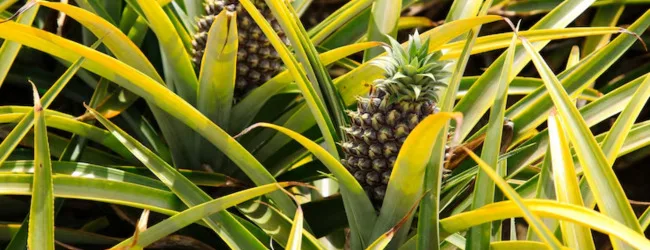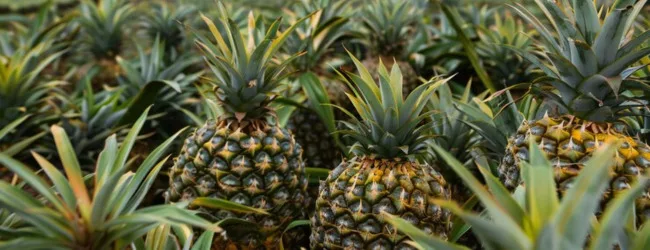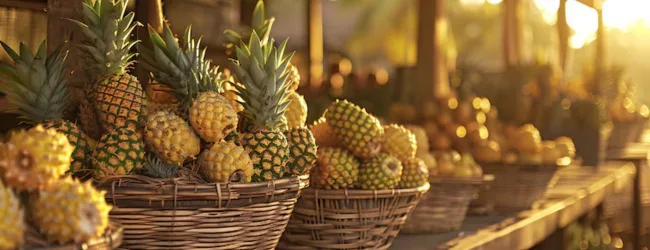Table of contents
- 1. Understanding Pineapple Farming in India
- 2. Selecting the Right Pineapple Variety
- 3. Preparing the Land for Planting
- 4. Planting Pineapple Suckers/Slips/Crowns
- 5. Irrigation and Nutrient Management
- 6. Weed Control
- 7. Pest and Disease Management
- 8. Harvesting Pineapples
- 9. Post-Harvest Handling and Storage
- 10. Marketing and Sales Strategies
- Conclusion
- Frequently Asked Questions (FAQs)
Pineapple farming in India presents a lucrative agricultural opportunity, thanks to the country’s diverse climate and growing demand for this tropical fruit. If you’re considering venturing into pineapple cultivation, this comprehensive guide will walk you through every crucial step, from initial setup costs to potential profits and beyond. We’ll break down the process into manageable segments, ensuring you have a clear roadmap for success in the Indian agricultural landscape.
1. Understanding Pineapple Farming in India

a. Why this Idea:
- High Demand: Pineapples are a popular fruit consumed fresh, processed into juices, jams, and used in various culinary applications across India.
- Favourable Climate: Several regions in India offer a warm and humid climate ideal for pineapple growth.
- Good Returns: With proper management and market access, pineapple farming can generate significant income.
- Government Support: The Indian government often promotes horticulture through various schemes and subsidies.
- Export Potential: There’s also an opportunity to tap into the international market for Indian pineapples.
b. Licenses Required:
- Generally, for small-scale farming, specific licenses might not be mandatory initially. However, it’s advisable to check with your local agricultural department for any registration requirements or permits.
- For large-scale commercial operations or if you plan to process or export pineapples, you might need licenses related to:
- Business registration: Registering your farm as a sole proprietorship, partnership, or private limited company.
- Food safety and standards: If you plan to process pineapples, adherence to FSSAI (Food Safety and Standards Authority of India) regulations is crucial.
- Export licenses: If you intend to export, you’ll need an Importer-Exporter Code (IEC) and other relevant export documentation.
c. Investment Required:
The initial investment in pineapple farming can vary significantly based on the scale of operation, land size, variety chosen, and farming practices. Key cost components include:
- Land preparation: Ploughing, levelling, and preparing the field for planting (₹10,000 – ₹25,000 per hectare).
- Planting material (suckers, slips, or crowns): Cost varies depending on the variety and source (₹50,000 – ₹1,50,000 per hectare).
- Fertilisers and pesticides: Input costs depend on soil health and pest/disease incidence (₹15,000 – ₹30,000 per hectare per year).
- Irrigation: Setting up irrigation systems (if required) can range from ₹20,000 to ₹1,00,000 per hectare, depending on the method (drip, sprinkler, etc.).
- Labour: Costs for planting, weeding, harvesting, and other operations (variable based on local wages).
- Equipment: Depending on the scale, you might need basic tools or machinery.
d. How to Sell:
- Local Markets: Selling directly to consumers or local vendors in nearby markets.
- Wholesalers and Commission Agents: Connecting with wholesalers who operate in larger agricultural markets.
- Processors: Supplying pineapples to juice manufacturing units, canning industries, or other food processing companies.
- Retail Chains: Partnering with supermarkets and retail outlets.
- Direct Marketing: Establishing your own brand and selling directly through online platforms or farm-to-consumer initiatives.
- Export: Exploring opportunities to export your produce through export agencies or by obtaining necessary certifications.
e. Any other Requirements:
- Suitable Land: Well-drained, acidic to slightly acidic soil with good organic matter content.
- Water Source: Reliable access to irrigation water, especially during dry periods.
- Technical Knowledge: Understanding best farming practices, pest and disease management, and post-harvest handling.
- Labour Availability: Access to skilled and unskilled labour for various farm operations.
f. Challenges in the Idea:
- High Initial Investment: The upfront costs for land preparation and planting material can be substantial.
- Long Gestation Period: Pineapples typically take 12-18 months to yield the first harvest.
- Pest and Disease Management: Susceptibility to various pests and diseases can impact yield and quality. Common issues include mealybugs, scale insects, and heart rot.
- Price Fluctuations: Market prices for pineapples can be volatile depending on supply and demand.
- Post-Harvest Losses: Pineapples are perishable, and inadequate post-harvest handling can lead to significant losses.
g. How to overcome the Challenges:
- Phased Investment: Start with a smaller area and gradually expand as you gain experience and capital.
- Intercropping: Plant short-duration crops in the initial phase to generate some income before the pineapple harvest.
- Integrated Pest Management (IPM): Adopt sustainable pest and disease control methods to minimise losses and environmental impact.
- Market Research: Thoroughly research market trends and establish connections with multiple buyers to mitigate price risks.
- Proper Post-Harvest Handling: Invest in proper harvesting techniques, cleaning, grading, and transportation to reduce spoilage. Consider cold storage options for extending shelf life.
2. Selecting the Right Pineapple Variety

a. Why this Idea: Different pineapple varieties have varying characteristics in terms of yield, fruit size, sweetness, disease resistance, and suitability for processing or fresh consumption. Selecting the right variety is crucial for maximising profitability.
b. Licenses Required: Generally, no specific licenses are required for growing different pineapple varieties. However, if you are dealing with patented or protected varieties, you might need agreements with the developers.
c. Investment Required: The cost of planting material can vary slightly depending on the variety. Researching reliable nurseries that provide healthy and certified planting material is important.
d. How to Sell: The market preference can vary for different varieties. For example, some varieties are preferred for fresh consumption due to their sweetness and appearance, while others are better suited for processing. Understanding the market demand will help you target the right buyers.
e. Any other Requirements: Understanding the specific climatic and soil requirements of the chosen variety is essential for optimal growth.
f. Challenges in the Idea: Choosing a variety that is not well-suited to your local climate or market preferences can lead to lower yields and reduced profitability.
g. How to overcome the Challenges: Conduct thorough research on the performance of different pineapple varieties in your region. Consult with agricultural experts and experienced farmers to make an informed decision. Consider conducting small-scale trials of different varieties before large-scale planting.
3. Preparing the Land for Planting
a. Why this Idea: Proper land preparation ensures good drainage, aeration, and nutrient availability, which are vital for healthy root development and plant growth.
b. Licenses Required: No specific licenses are typically required for land preparation.
c. Investment Required: Costs include ploughing, harrowing, levelling, and potentially soil treatment (e.g., adding organic matter or adjusting pH).
d. How to Sell: Proper land preparation indirectly impacts the quality and yield of your pineapples, making them more attractive to buyers.
e. Any other Requirements: Conducting a soil test to determine nutrient deficiencies and pH levels is highly recommended. Based on the results, you can take corrective measures.
f. Challenges in the Idea: Poor soil drainage can lead to root rot, while nutrient deficiencies can stunt growth. Improper levelling can cause waterlogging in some areas and dryness in others.
g. How to overcome the Challenges: Invest in proper land surveying and levelling. Improve soil drainage by creating raised beds or using drainage channels. Amend the soil with organic matter and fertilisers based on soil test recommendations.
4. Planting Pineapple Suckers/Slips/Crowns
a. Why this Idea: Using healthy and disease-free planting material and following proper planting techniques are crucial for establishing a uniform and productive pineapple plantation.
b. Licenses Required: No specific licenses are usually required for planting. However, ensure your planting material is sourced from certified nurseries to avoid introducing diseases.
c. Investment Required: The cost of suckers, slips, or crowns is a significant part of the initial investment. Labour costs for planting also need to be considered.
d. How to Sell: Healthy and uniformly grown plants lead to better quality and higher yields, which are more marketable.
e. Any other Requirements: Selecting the right type of planting material (suckers, slips, or crowns) based on availability and cost. Treating the planting material with fungicides before planting can help prevent early diseases. Maintaining appropriate spacing between plants is essential for optimal growth and air circulation.
f. Challenges in the Idea: Using diseased or damaged planting material can lead to poor establishment and disease spread. Improper planting depth or spacing can negatively impact growth and yield.
g. How to overcome the Challenges: Source planting material from reputable and certified nurseries. Inspect the material thoroughly before planting and discard any damaged or diseased ones. Follow recommended planting depth and spacing guidelines for the chosen variety. Treat the planting material with appropriate fungicides.
5. Irrigation and Nutrient Management

a. Why this Idea: Pineapples require adequate moisture and nutrients for healthy growth and fruit development. Proper irrigation and nutrient management significantly impact yield and quality.
b. Licenses Required: No specific licenses are usually required for irrigation and fertilisation, but adhering to environmental regulations regarding water usage and fertiliser application is important.
c. Investment Required: Costs include setting up irrigation systems (if needed) and purchasing fertilisers.
d. How to Sell: Well-nourished and adequately watered plants produce larger, juicier, and better-quality fruits, which command higher prices in the market.
e. Any other Requirements: Understanding the water requirements of pineapples at different growth stages. Conducting regular soil and leaf analysis to determine nutrient deficiencies and adjust fertiliser application accordingly. Choosing the right type and dosage of fertilisers.
f. Challenges in the Idea: Over-irrigation can lead to root rot, while under-irrigation can stress the plants and reduce yield. Imbalanced fertilisation can also negatively impact growth and fruit quality.
g. How to overcome the Challenges: Implement efficient irrigation methods like drip irrigation to conserve water and deliver it directly to the root zone. Schedule irrigation based on weather conditions and plant needs. Apply fertilisers based on soil and leaf analysis recommendations. Use a balanced mix of macro and micronutrients.
6. Weed Control
a. Why this Idea: Weeds compete with pineapple plants for water, nutrients, and sunlight, leading to reduced growth and yield. Effective weed control is crucial for maximising productivity.
b. Licenses Required: No specific licenses are usually required for weed control. However, if using herbicides, ensure they are approved and used according to safety guidelines.
c. Investment Required: Costs include manual labour for weeding, mulching materials, or herbicides.
d. How to Sell: Weed-free fields contribute to healthier pineapple plants and better-quality fruits.
e. Any other Requirements: Choosing appropriate weed control methods based on the type and intensity of weed infestation. Options include manual weeding, mulching, and herbicide application.
f. Challenges in the Idea: Weeds can grow rapidly in tropical climates, requiring frequent control measures. Herbicide misuse can harm pineapple plants and the environment.
g. How to overcome the Challenges: Implement a combination of weed control methods. Use mulching to suppress weed growth and conserve soil moisture. If using herbicides, follow label instructions carefully and consider integrated weed management strategies.
7. Pest and Disease Management

a. Why this Idea: Pests and diseases can cause significant damage to pineapple plants and fruits, leading to substantial yield losses. Proactive and effective management is essential for a successful harvest.
b. Licenses Required: No specific licenses are usually required for general pest and disease management. However, for using certain pesticides, you might need to be a certified applicator.
c. Investment Required: Costs include purchasing pesticides, fungicides, and application equipment.
d. How to Sell: Disease-free and pest-free fruits are of higher quality and more appealing to buyers.
e. Any other Requirements: Regularly monitoring the plants for signs of pests and diseases. Identifying the specific pests and diseases affecting your crop. Choosing appropriate control measures, which can include biological control, cultural practices, and chemical treatments.
f. Challenges in the Idea: Identifying pests and diseases accurately can be challenging. Some pests and diseases can spread rapidly and cause significant damage before detection. Pesticide resistance can also be an issue.
g. How to overcome the Challenges: Regularly scout your fields for pests and diseases. Consult with agricultural experts for accurate identification and recommended control measures. Implement integrated pest and disease management (IPM) strategies that combine various methods to minimise reliance on chemical pesticides.
ALSO READ | Top 7 Farming Business Ideas That Will Boom in India by 2025
8. Harvesting Pineapples
a. Why this Idea: Harvesting at the right stage of maturity ensures optimal flavour, sweetness, and shelf life of the fruits. Improper harvesting can lead to reduced quality and post-harvest losses.
b. Licenses Required: No specific licenses are usually required for harvesting.
c. How to Sell: Properly harvested, mature pineapples are more attractive to consumers and fetch better prices.
d. Any other Requirements: Knowing the visual cues and maturity indices for the specific pineapple variety you are growing (e.g., change in fruit colour, development of eye flatness, tapping sound). Using appropriate tools for harvesting to avoid damaging the fruits.
e. Challenges in the Idea: Determining the precise time of harvest can be trick,y as maturity can vary within a field. Harvesting immature or overripe fruits can lead to quality issues.
f. How to overcome the Challenges: Regularly monitor the development of fruits and learn the specific maturity indicators for your variety. Harvest fruits selectively as they reach the optimal stage. Train labourers on proper harvesting techniques.
9. Post-Harvest Handling and Storage
a. Why this Idea: Implementing proper post-harvest practices to maintain the quality and extend the shelf life of harvested pineapples.
b. Licenses Required: If you plan to store pineapples for extended periods or process them, you might need licenses related to storage and food safety.
c. Investment Required: Costs for cleaning, grading, packaging materials, and potentially cold storage facilities.
d. How to Sell: Well-handled and properly stored pineapples have a longer shelf life and can reach distant markets, increasing your potential customer base.
e. Any other Requirements: Cleaning the harvested fruits to remove dirt and debris. Grading the fruits based on size, weight, and quality. Proper packaging to prevent physical damage during transportation. Maintaining optimal temperature and humidity during storage.
f. Challenges in the Idea: Pineapples are susceptible to bruising and decay. Maintaining the right storage conditions can be expensive. Transportation to distant markets can be challenging.
g. How to overcome the Challenges: Handle fruits carefully during harvesting and post-harvest operations. Invest in appropriate packaging materials. Explore cost-effective storage solutions. Establish efficient transportation networks.
10. Marketing and Sales Strategies

a. Why this Idea: A well-defined marketing and sales strategy ensures you reach your target customers and obtain the best possible prices for your produce.
b. Licenses Required: Business registration and potentially licenses related to selling in specific markets or exporting.
c. Investment Required: Costs for transportation, marketing materials, and potentially commission for agents.
d. How to Sell: By implementing effective marketing strategies, you can reach a wider audience and build strong relationships with buyers.
e. Any other Requirements: Identifying your target market (local consumers, wholesalers, processors, retailers, exporters). Developing a pricing strategy. Building relationships with potential buyers. Exploring different sales channels (direct sales, wholesale markets, online platforms).
f. Challenges in the Idea: Competition from other pineapple growers. Price fluctuations in the market. Reaching the right buyers. Transportation costs.
g. How to overcome the Challenges: Differentiate your produce through quality and branding. Explore value-added processing (e.g., juice, jams). Build strong relationships with buyers. Explore niche markets or direct-to-consumer sales. Optimise transportation logistics.
ALSO READ | Onion Farming in India: A Complete Guide [Setup Cost, Profit & More]
Conclusion
Pineapple farming in India offers a promising avenue for agricultural entrepreneurship. By carefully considering each step, from selecting the right variety and preparing the land to implementing effective farming practices and marketing strategies, you can establish a successful and profitable pineapple farming venture. Remember to stay updated on the latest agricultural advancements and market trends to ensure long-term sustainability and growth.
Frequently Asked Questions (FAQs)
1. Which are the major pineapple-growing states in India?
Assam, West Bengal, Kerala, Karnataka, Meghalaya, Tripura, and Mizoram are the major pineapple-producing states in India.
2. What is the ideal climate for pineapple cultivation?
Pineapples thrive in warm and humid tropical climates with temperatures ranging from 15°C to 30°C and well-distributed rainfall of 100-150 cm per year.
3. How long does it take for a pineapple plant to bear fruit?
Generally, it takes about 12-18 months from planting to the first harvest, depending on the variety and growing conditions.
4. What is the average yield of pineapple per hectare in India?
The average yield can vary from 15 to 25 tonnes per hectare, depending on the variety, planting density, and management practices.
5. What are the common pests and diseases affecting pineapple crops?
Common pests include mealybugs, scale insects, and nematodes. Common diseases include heart rot, fruit rot, and wilt.
6. What are the different methods of pineapple propagation?
Pineapples are typically propagated using suckers (shoots that develop at the base of the plant), slips (shoots that grow below the fruit), and crowns (the leafy top of the fruit).
7. Is intercropping beneficial in pineapple farming?
Yes, intercropping with short-duration crops like legumes or vegetables during the initial growth stages of pineapple can help generate additional income and improve soil health.
8. What are some value-added products that can be made from pineapples?
Pineapples can be processed into juice, jams, jellies, candies, dried fruit, and used in various culinary preparations like pickles and chutneys.


